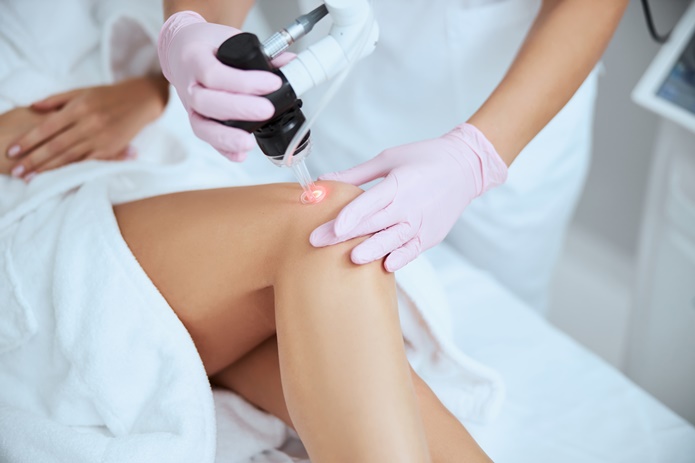
Spider veins, also known as telangiectasias, are small, thin veins that appear near the skin's surface. They are usually blue, purple, or red and can resemble spider webs or tree branches. Spider veins are common in men and women and can appear on various body parts, including the legs, face, and arms. While spider veins are not typically harmful, they can be unsightly and may cause discomfort or aching in some cases.
Spider veins can develop due to various factors, including genetics, hormonal changes, pregnancy, obesity, and prolonged periods of standing or sitting. Other factors contributing to the development of spider veins include sun exposure, injury, and certain medications.
Genetics play a significant role in developing spider veins, so if your parents or close family members have them, you are more likely to develop them. In addition, hormonal changes during pregnancy or menopause can increase your risk of developing spider veins. Similarly, hormonal therapies such as birth control pills or hormone replacement therapy can also contribute to their development.
Obesity can increase the pressure on the veins in your legs and lead to spider veins, as can prolonged periods of standing or sitting. Finally, sun exposure can damage the skin and veins, causing spider veins to appear. Injuries to the affected area or certain medications, such as corticosteroids, can also contribute to developing spider veins.
If you are bothered by the appearance of spider veins, several spider vein treatment options are available. The most common spider vein treatments include sclerotherapy, laser therapy, and radiofrequency ablation.
Sclerotherapy is a minimally invasive procedure that involves injecting a solution directly into the affected veins. This causes the veins to collapse and eventually fade away. Sclerotherapy is typically performed on an outpatient basis and has a high success rate.
Laser therapy uses intense light beams to target and destroy the affected veins. This treatment is typically reserved for smaller spider veins and may require several sessions to achieve optimal results.
Radiofrequency ablation is a newer spider vein treatment option that uses radiofrequency energy to heat and closes off the affected veins. This treatment is typically reserved for larger spider veins and can be performed as outpatient.
Other spider vein treatment options include surface laser treatments, vein stripping, and endovenous laser therapy. Surface laser treatments involve the use of a laser to heat the spider veins and cause them to fade away over time. Vein stripping is a surgical procedure that involves removing the affected veins through small incisions. Endovenous laser therapy involves using laser energy to close off the affected veins and redirect blood flow to healthy veins.
The best spider vein treatment for you will depend on several factors, including the size and location of your spider veins, overall health, and treatment goals. Therefore, it is important to consult a qualified vein specialist to determine the best treatment option for your needs.
During your initial consultation, your doctor will thoroughly evaluate your spider veins and discuss your treatment goals with you. They will also review your medical history and any medications you are currently taking to determine the best treatment plan for you.
In general, sclerotherapy is the preferred spider vein treatment, while laser therapy and radiofrequency ablation are typically reserved for larger or more complex spider veins. Depending on the severity and location of your spider veins, surface laser treatments, vein stripping, and endovenous laser therapy may also be options.
Most spider vein treatments are minimally invasive and require little to no downtime. For example, sclerotherapy and surface laser treatments typically require only a day or two of rest before you can resume normal activities. Laser therapy and radiofrequency ablation may require slightly longer recovery times, but most people can return to work and other daily activities within a few days.
It is important to note that spider vein treatment is a gradual process, and it may take several sessions to achieve optimal results. You may also experience some bruising or swelling after treatment, but these side effects usually subside within a few days.
Once your spider veins have been treated, you can expect to see a significant improvement in their appearance. However, it is important to note that spider veins can recur over time, so it is important to maintain a healthy lifestyle and follow your doctor's recommendations for long-term care.
While spider veins cannot always be prevented, there are steps you can take to reduce your risk of developing them. Maintaining a healthy weight, staying active, and avoiding prolonged periods of standing or sitting can all help prevent spider veins.
Wearing compression stockings or socks can also help improve blood flow and reduce the risk of spider veins. If you are pregnant or taking hormonal medications, talk to your doctor about ways to reduce your risk of developing spider veins.
Spider veins can be unsightly and may cause discomfort or aching, but several treatment options are available to help improve their appearance and alleviate any symptoms. If you are considering spider vein treatment, it is important to consult with a qualified vein specialist to determine the best treatment plan for your individual needs.
Sclerotherapy, laser therapy, and radiofrequency ablation are all effective spider vein treatment options, and most people can expect to see significant improvement in their appearance after treatment. However, it is also important to prevent spider veins, such as maintaining a healthy weight, staying active, and wearing compression stockings if recommended.
If you are concerned about spider veins or want more information about spider vein treatment, contact Utah Vein Specialists at 801-501-8346 to schedule a consultation.